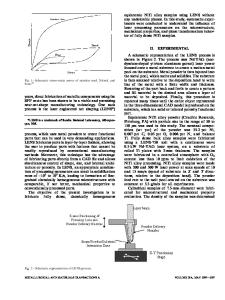Two-Way Shape Memory Surfaces
- PDF / 308,787 Bytes
- 5 Pages / 612 x 792 pts (letter) Page_size
- 1 Downloads / 320 Views
0979-HH05-03
Two-Way Shape Memory Surfaces Yijun Zhang1,2, Yang-Tse Cheng2, and David S Grummon1 1 Department of Chemical Engineering and Materials Science, Michigan State University, East Lansing, MI, 48823 2 Materials and Processes Laboratory, General Motors Research and Development Center, Warren, MI, 48090
ABSTRACT Recently, we discovered that a two-way shape memory effect can be realized on NiTi shape memory alloy surfaces by spherical indentation. Either thermomechanical cycling or slipplastic deformation under contact loading conditions is effective in inducing reversible indent depth changes: deeper indents in the low temperature martensitic phase and shallower indents in the high temperature austenitic phase [1, 2]. By planarization of these spherical indents to restore a flat surface, circular reversible surface protrusions appear upon heating and disappear upon cooling. Nano-protrusions are also realized in sputter deposited NiTi thin films. Furthermore, two-way reversible line protrusions are made by planarizing scratch tracks on a NiTi shape memory alloy. Shape memory surfaces can be exploited for a wide range of potential applications, including information storage, optical devices, and smart tribological surfaces. INTRODUCTION The shape memory alloys (SMA) like NiTi have the ability of recovering deformation in the martensite phase upon heating to the austenite phase [3]. This is the shape memory effect (SME), which only occurs in the martensite-to-austenite phase transformation. The two-way shape memory effects (TWSME) is the ability to deform reversibly without the assistance of external stress in both directions of martensite-austenite phase transformations. The TWSME can be developed in shape memory alloys by certain thermomechanical treatment called “training” [4]. Common training procedures include thermomechanical cycling [5], aging under external stress [6], and plastic deformation [7, 8]. Although various training methods have been developed, the basic mechanism of the TWSME is still elusive. It is believed that either residual martensite or dislocations resulted from the training is the main cause for the TWSME [9], though more evidence supports dislocations and their corresponding internal stress fields than residual martensites [10, 11]. Microstructures, including second phase and grain size, also affect the stability and magnitude of the TWSME [12]. The fatigue behavior of TWSME is nonlinear, characterized by stabilization after initial degradation [13]. However, previous training methods were all based on simple loading conditions: uniaxial tensile, shearing, or bending. We show that TWSME can also exist under complex loading conditions produced by indentations. Specifically, the indent is deeper in depth in the martensite phase at low temperature and becomes shallower in the austenite phase at high temperature. Both thermomechanical and plastic training can produce robust TWSME. After the indents are removed in the martensite phase by mechanical polishing to restore flat surface, reve
Data Loading...











